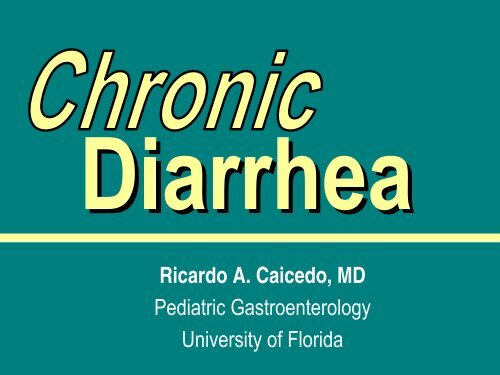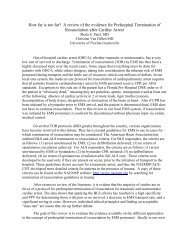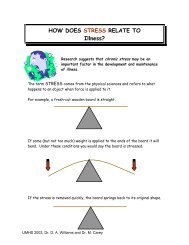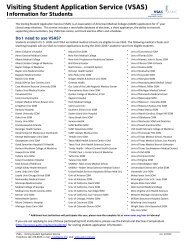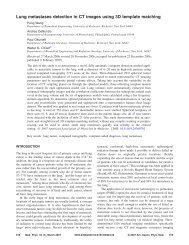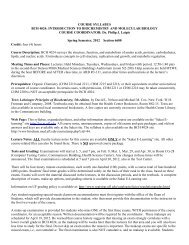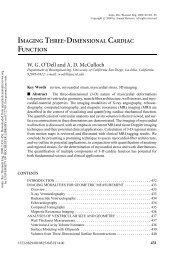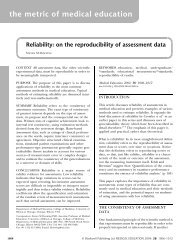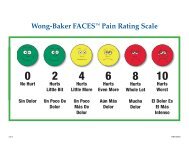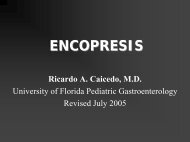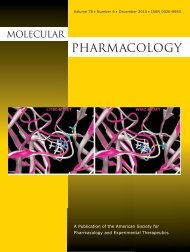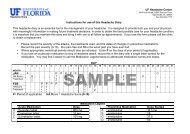Chronic Diarrhea - Pediatric Residency Program - University of Florida
Chronic Diarrhea - Pediatric Residency Program - University of Florida
Chronic Diarrhea - Pediatric Residency Program - University of Florida
Create successful ePaper yourself
Turn your PDF publications into a flip-book with our unique Google optimized e-Paper software.
Ricardo A. Caicedo, MD<br />
<strong>Pediatric</strong> Gastroenterology<br />
<strong>University</strong> <strong>of</strong> <strong>Florida</strong>
<strong>Diarrhea</strong><br />
MECHANISM<br />
MALABSORPTION<br />
OSMOTIC<br />
SECRETORY<br />
HYPERMOTILITY<br />
INFLAMMATORY<br />
Increase in frequency and water<br />
content <strong>of</strong> stools<br />
Examples<br />
Celiac disease, Rotavirus<br />
Lactase deficiency<br />
Cholera, C. difficile toxin<br />
IBS<br />
IBD, Shigella
Acute <strong>Diarrhea</strong><br />
• Infection<br />
– Viral gastroenteritis<br />
• Rotavirus<br />
• Enterovirus, adenovirus<br />
• Norwalk virus<br />
– Bacterial enterocolitis<br />
• Shigella, Salmonella<br />
• Yersinia, Campylobacter<br />
• E.coli – enteroinvasive<br />
• C. difficile<br />
– Foodborne<br />
• S.aureus, Bacillus cereus<br />
• E. coli – enterotoxigenic<br />
– Other: UTI, OM<br />
• Inflammatory<br />
– Hemolytic Uremic Syndrome (HUS)<br />
– Henoch-Schonlein Purpura (HSP)<br />
• Anatomic<br />
– Intussusception<br />
– Appendicitis<br />
• Toxic Ingestion<br />
– Iron, mercury, lead<br />
• Other<br />
– Antibiotic-induced<br />
– Hyperconcentrated infant formula<br />
– Overfeeding infants
<strong>Chronic</strong> <strong>Diarrhea</strong><br />
• Infection – parasitic<br />
– Giardia lamblia<br />
– Entamoeba histolytica<br />
– Cryptosporidium parvum<br />
• Inflammatory<br />
– Milk protein intolerance<br />
– Food allergy<br />
– IBD<br />
Duration > 2 weeks<br />
• Malabsorption<br />
– Celiac disease<br />
– Cystic fibrosis<br />
– Bacterial overgrowth<br />
• Osmotic<br />
– Lactase deficiency<br />
• Primary<br />
• Secondary post-infectious<br />
– Excessive fructose intake<br />
– Laxative overuse
Parasitic<br />
Organism Sources Duration<br />
Giardia Fecal-oral, water supplies 2 wks – years<br />
Entamoeba Same Weeks<br />
Cryptosporidium<br />
Cyclospora<br />
Same, plus petting zoos,<br />
swimming pools<br />
Water, unpasteurized apple<br />
cider<br />
2 wks<br />
1wk-1month<br />
Isospora Fecal-oral, water > 2 wks<br />
Strongyloides<br />
Fecal-oral<br />
Appalachia<br />
same<br />
Blastocystis hominis Pathogenic? Tan KS et al (2002) Int J Parasitol 32: 789-804<br />
Keating J (2005) Pediatr Rev 26: 5-13.
Giardiasis<br />
• Presentation<br />
– Watery, foul stools<br />
– Abdominal distention<br />
• Bloating, flatulence<br />
– Crampy abdominal pain<br />
– Malaise, weakness<br />
– Nausea/vomiting<br />
– Anorexia, wt loss<br />
• Risk factors<br />
– Well water<br />
– Daycare<br />
– Public pools, summer camp<br />
– Immunodeficiency<br />
• Diagnosis<br />
– Stool antigen test<br />
• Greater sensitivity than O+P<br />
• Simpler than duodenal bx<br />
– Often overlooked<br />
• Fever, WBC, eosinophilia rare<br />
• Natural history<br />
– Most become asx by 6 wks<br />
– Frequent re-infx (up to 35%)<br />
– Few develop prolonged diarrhea<br />
with wt loss and growth failure<br />
• Treatment<br />
– Flagyl 15 mg/kg/d X 10 d<br />
• Albendazole, furazolidone<br />
• Asx carriers usually not treated
Prolonged Viral/Bacterial <strong>Diarrhea</strong>s<br />
Agent Sources Duration<br />
Adenovirus, Rotavirus,<br />
CMV<br />
Avg. 11 d<br />
Months in immunodeficient<br />
C. difficile Abx, nosocomial Relapses in 10% <strong>of</strong> cases<br />
Campylobacter<br />
Raw poultry, unpasteurized<br />
milk, contaminated water<br />
5 d - weeks<br />
Salmonella Poultry, fecal-oral Months in infants<br />
Yersinia<br />
Raw pig intestines, fecaloral<br />
3 wks -3 months<br />
Aeromonas Untreated water 1 wk – 1 yr<br />
Keating J (2005) Pediatr Rev 26: 5-13.
Prolonged <strong>Diarrhea</strong> in Infants<br />
• Prolonged/recurrent<br />
diarrhea<br />
• Failure to gain weight<br />
“Slick Gut” Syndrome<br />
– Intractable diarrhea <strong>of</strong><br />
infancy, postenteritis<br />
enteropathy<br />
– Metabolic acidosis<br />
– Treatment<br />
• Initial lactose-free, sucrosefree<br />
formula<br />
• Elemental formula<br />
• TPN<br />
= diagnosable by SB bx<br />
Sucrase-isomaltase deficiency<br />
due to malrotation<br />
OTHER:<br />
Immunodeficiency<br />
CF<br />
VIPoma<br />
Abetalipoproteinemia<br />
Celiac disease<br />
Congenital intestinal<br />
lymphangiectasia
Small bowel biopsy<br />
Tufting enteropathy<br />
No effective tx<br />
Congenital<br />
lymphangiectasia<br />
Protein losing enteropathy<br />
Villous clubbing<br />
Subepithelial bleb<br />
MCT and high protein diet<br />
Microvillus inclusion disease<br />
Neonatal<br />
Apical membrane autophagocytosis<br />
Consanguinity<br />
TPN-dependence, SB Transplant
Toddler’s diarrhea<br />
• <strong>Chronic</strong> nonspecific diarrhea <strong>of</strong> childhood<br />
• Symptoms<br />
– Explosive loose stools<br />
– Contain food particles<br />
– Frequent stools, decline as day goes on<br />
• Management<br />
– Verify normal growth and absence <strong>of</strong> red flags<br />
• Blood in stool, persistent fever, anemia<br />
– Exclude celiac disease (tTG) and Giardia<br />
– Trial <strong>of</strong> dietary modification<br />
• Restrict fructose and/or lactose
<strong>Diarrhea</strong> in older children<br />
• OSMOTIC<br />
– Lactase deficiency<br />
• Primary<br />
– African, Asian, Hispanic<br />
• Secondary<br />
– Postenteritis<br />
– Laxative overuse/Poisoning<br />
• INFLAMMATORY<br />
– Infectious<br />
– IBD<br />
• FUNCTIONAL/hypermotility<br />
– IBS<br />
– CNSD (Toddler’s)<br />
• MALABSORPTIVE<br />
– Celiac disease<br />
– CF<br />
– Pancreatic insufficiency steatorrhea<br />
– <strong>Chronic</strong> cholestasis<br />
– Bacterial overgrowth<br />
– Zinc deficiency<br />
– Intestinal lymphangiectasia<br />
• Cong. Heart Dz (Fontan physiol)<br />
• Tumor or radiation<br />
• SECRETORY
Secretory diarrheas<br />
• Voluminous watery<br />
• Persists despite bowel rest<br />
• Massive efflux <strong>of</strong> fluid/salt<br />
• Stool electrolyte content<br />
similar to serum<br />
• WDHA syndrome<br />
– Watery diarrhea<br />
– Hypokalemia<br />
– Alkalosis<br />
• DIFFERENTIAL DX<br />
– Cholera<br />
– C. difficile<br />
– Severe mucosal injury<br />
– Short bowel syndrome<br />
– Secretory tumors<br />
• Carcinoid<br />
• Gastrinoma<br />
• Ganglioneuroma<br />
• Neuroblastoma<br />
• Pheochromocytoma<br />
• VIPoma
Zinc deficiency<br />
• Acrodermatitis enteropathica<br />
– Perineal and perioral rash<br />
– <strong>Chronic</strong> diarrhea & undernutrition<br />
– Low serum Zn and alk phos<br />
– Primary<br />
• Rare, recessive, mutation in Zn transporter<br />
– Secondary<br />
• CF<br />
• Crohn’s<br />
• Anorexia nervosa<br />
• Dialysis<br />
• <strong>Chronic</strong> TPN<br />
• Exclusively breastfed preterms<br />
– Tx = longterm Zn supplementation
Immunodeficiency<br />
CONDITION<br />
Immunosuppression<br />
HIV<br />
SCID<br />
CGD<br />
Wiskott<br />
CVID<br />
Hyper IgM<br />
Selective IgA deficiency<br />
MHC II deficiency<br />
DIARRHEA<br />
CMV colitis, Cryptosporidium, Isospora,<br />
Entamoeba, Microspora, Cyclospora<br />
Cryptosporidium, Giardia, +/- VIP-oma<br />
50% have protracted diarrhea in infancy<br />
Crohn-like colitis early in life<br />
IBD-like early in life<br />
Campy, Giardia<br />
50% have chronic diarrhea<br />
Increased risk <strong>of</strong> chronic giardiasis<br />
Death in infancy due to severe malabsorption
Approach<br />
• Impact <strong>of</strong> diarrhea<br />
– How is the infant/child growing?<br />
– How is symptom affecting child’s life?<br />
• Mechanism <strong>of</strong> diarrhea<br />
– Description <strong>of</strong> stool<br />
• Blood? Oily? Food particles?<br />
• Frequency<br />
– Diet and exposures<br />
• Complete physical exam<br />
– Attention to skin, LN, spleen<br />
• Screening and diagnostic tests
Screening tests<br />
• BLOOD<br />
– Electrolytes<br />
– Total protein/albumin<br />
– Liver tests<br />
– CBC<br />
– ESR<br />
– Celiac serology (tTG)<br />
– Vitamin levels<br />
• B12, FA, Fe<br />
• A, D, E<br />
• STOOL<br />
– Guaiac<br />
– pH and reducing substances<br />
– Spot fat stain<br />
– Gram stain/Culture<br />
– Giardia Ag<br />
– O+P<br />
– C. diff toxin<br />
– Osmolarity<br />
– Electrolytes
Secretory vs. Osmotic<br />
Osmotic Gap: 290 – {2 ([Na + ] +[ K + ])}<br />
Stool Na > 70<br />
Osmotic Gap < 100<br />
Persists while NPO<br />
Stool Na < 70<br />
Osmotic Gap > 100<br />
Decreases when NPO
Malabsorption studies<br />
• FAT<br />
– Spot fecal fat stain<br />
– Quantitative 72 hr<br />
• Total excretion > 5g fat/24 h<br />
• Coefficient <strong>of</strong> absorption =<br />
(fat ingested –<br />
excreted)/ingested X 100%<br />
• PROTEIN<br />
– Fecal A1AT<br />
• Suggests mucosal disorder<br />
such as celiac disease<br />
• CARBOHYDRATE<br />
– Stool pH < 5.5<br />
– Reducing sugars<br />
• Lactose, maltose, fructose,<br />
galactose<br />
– Breath hydrogen test<br />
• H2 produced by bacterial<br />
fermentation <strong>of</strong> undigested<br />
CHO<br />
• Rise in H2 > 20 ppm above<br />
baseline: malabs.<br />
• Elevated baseline or ∆20<br />
ppm w/in 30 min: overgrowth
Barney Beagle<br />
Thank You!


